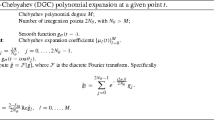Abstract
A numerical study is presented for the eigensolution statistics of largeN×N real and symmetric sparse random matrices as a function of the mean numberp of nonzero elements per row. The model shows classical percolation and quantum localization transitions atp c =1 andp q >1, respectively. In the rigid limitp=N we demonstrate that the averaged density of states follows the Wigner semicircle law and the corresponding nearest energy-level-spacing distribution functionP(S) obeys the Wigner surmise. In the very sparse matrix limitp≪N, withp>p q a singularity 〈ρ(E))∝1/¦E¦ is found as¦E¦→ 0 and exponential tails develop in the high-¦E¦ regions, but theP(S) distribution remains consistent with level repulsion. The localization properties of the model are examined by studying both the eigenvector amplitude and the density fluctuations. The valuep q 1.4 is roughly estimated, in agreement with previous studies of the Anderson transition in dilute Bethe lattices.
Similar content being viewed by others
References
E. P. Wigner,Ann. Math. 62:548 (1955);65:203 (1957).
F. Dyson,J. Math. Phys. 3:140 (1962);3:1199 (1962).
C. E. Porter,Statistical Theories of Spectra: Fluctuations (Academic Press, New York, 1965).
M. L. Mehta,Random Matrices and the Statistical Theory of Energy Levels (Academic Press, New York, 1967).
E. N. Economou,Green's Functions in Quantum Physics (Springer, New York, 1983).
P. W. Anderson,Phys. Rev. 109:1492 (1958).
D. Staufler,Introduction to Percolation Theory (Taylor and Francis, London, 1985); see also D. Stauffer and A. Aharony,Introduction to Percolation Theory, 2nd ed. (1992).
R. B. Griffiths,Phys. Rev. Lett. 23:17 (1969).
J. R. Banavar, D. Sherrington, and N. Sourlas,J. Phys. A 20:L1 (1987); M. Mezard and G. Parisi,J. Phys. Lett. (Paris)46:L771 (1985).
S. N. Evangelou and E. N. Economou,Phys. Rev. Lett. 68:361 (1992).
G. J. Rodgers and A. J. Bray,Phys. Rev. B 37:3557 (1988).
G. J. Rodgers and C. De Dominicis,J. Phys. A 23:1567 (1990).
A. D. Mirlin and Y. V. Fyodorov,J. Phys. A 24:2273 (1991).
Y. V. Fyodorov and A. D. Mirlin,Phys. Rev. Lett. 67:2049 (1991).
B. L. Al'tshuler, I. Kh. Zharekeshev, S. A. Kotochigova, and B. I. Shklovskii,Sov. Phys. JETP 67:625 (1988).
Y. Imry,Europhysics Lett. 1:249 (1986).
S. N. Evangelou,Phys. Rev. B 39:12895 (1989).
F. Haake,Quantum Signatures of Chaos (Springer, Berlin, 1991).
S. N. Evangelou,Phys. Rev. B 27:1397 (1983).
S. Kirkpatrick and T. P. Eggarter,Phys. Rev. B 6:3598 (1972).
F. Dyson,Phys. Rev. 92:1331 (1953).
S. N. Evangelou,J. Phys. C 19:4291 (1986);J. Condensed Matter 2:2953 (1990).
A. B. Harris,Phys. Rev. B 27:1397 (1985).
S. A. Molcanov,Commun. Math. Phys. 78:429 (1981).
S. N. Evangelou and E. N. Economou,Phys. Lett. A 151:345 (1990).
G. Casati, L. Molinary, and F. Israilev,Phys. Rev. Lett. 64:1851 (1990).
Author information
Authors and Affiliations
Rights and permissions
About this article
Cite this article
Evangelou, S.N. A numerical study of sparse random matrices. J Stat Phys 69, 361–383 (1992). https://doi.org/10.1007/BF01053797
Received:
Revised:
Issue Date:
DOI: https://doi.org/10.1007/BF01053797




